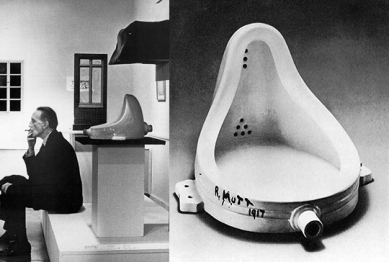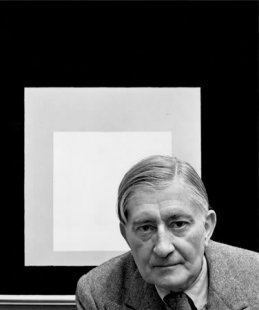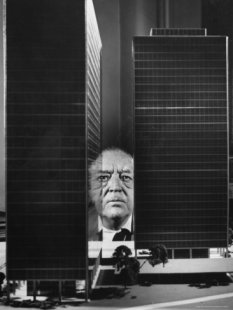
Tadao Ando: Representation and Abstraction
The answer to the question of whether architecture is abstract or a representation I find difficult, as I believe it is both.
The word "abstract" reminds me of the triumphant abstract paintings of twentieth-century painters, and I am particularly drawn to the work of one of the Bauhaus artists, Josef Albers. His understanding of "perception" was dramatically opposite to that of the suprematist Kazimir Malevich. The series that Albers called "Homage to the Square" represents the pinnacle of modern painting for me. Albers took the effort to express the square in the most thorough way possible, but it was not just a systematic depiction of all possible variations of composition. While Malevich's goal was absolute purity of human senses, Albers’s method allowed for ambiguous perception. The artist, working within the confines of the square, used distinctive, transparent colors. The observer perceives a subtle vibration and expansion within the work and experiences various modes of freedom.(...)
What, however, does representation mean in relation to architecture? For me, it is the physical or sensory quality of architecture or better, the labyrinth-like quality of the body. It reminds me of Piranesi's "Carceri d'invezione." Their overwhelming power and extraordinary sense of space have long remained fresh in my memories. These dreamlike prisons, much like the works of Escher, full of tricks, exactly correspond to my ideas of a labyrinth within the body.
For the forms of my architecture, I choose simple circles and squares. Just as Albers manipulates squares using different colors, I manipulate or create visible spaces. The result is an architecture that, transformed from something very abstract and constructed according to strictly geometric rules into a visible representation, bears the imprint of the human body. I believe that this transformation is possible thanks to the similarity of my work to a labyrinth. As the main goal of my work, I see creating architecture that is simultaneously both abstraction and representation due to the fact that I give expression to simple abstract shapes resembling a labyrinth - that is, I conceal an imaginary Piranesian labyrinth within frames similar to Albers's. At the same time, I have another goal related to nature, as something opposite to human reason. Just like a labyrinth, nature is an important element that gives architecture the quality of representation. I want to see if these two elements can exist together, separately yet concurrently, within one work. I strive to place a building within nature that conceals a labyrinth and to embed nature into architecture - thus creating nature made by man. Like a basso ostinato, this theme appears in all my works, even though I have not always been aware of it.
The word "abstract" reminds me of the triumphant abstract paintings of twentieth-century painters, and I am particularly drawn to the work of one of the Bauhaus artists, Josef Albers. His understanding of "perception" was dramatically opposite to that of the suprematist Kazimir Malevich. The series that Albers called "Homage to the Square" represents the pinnacle of modern painting for me. Albers took the effort to express the square in the most thorough way possible, but it was not just a systematic depiction of all possible variations of composition. While Malevich's goal was absolute purity of human senses, Albers’s method allowed for ambiguous perception. The artist, working within the confines of the square, used distinctive, transparent colors. The observer perceives a subtle vibration and expansion within the work and experiences various modes of freedom.(...)
What, however, does representation mean in relation to architecture? For me, it is the physical or sensory quality of architecture or better, the labyrinth-like quality of the body. It reminds me of Piranesi's "Carceri d'invezione." Their overwhelming power and extraordinary sense of space have long remained fresh in my memories. These dreamlike prisons, much like the works of Escher, full of tricks, exactly correspond to my ideas of a labyrinth within the body.
For the forms of my architecture, I choose simple circles and squares. Just as Albers manipulates squares using different colors, I manipulate or create visible spaces. The result is an architecture that, transformed from something very abstract and constructed according to strictly geometric rules into a visible representation, bears the imprint of the human body. I believe that this transformation is possible thanks to the similarity of my work to a labyrinth. As the main goal of my work, I see creating architecture that is simultaneously both abstraction and representation due to the fact that I give expression to simple abstract shapes resembling a labyrinth - that is, I conceal an imaginary Piranesian labyrinth within frames similar to Albers's. At the same time, I have another goal related to nature, as something opposite to human reason. Just like a labyrinth, nature is an important element that gives architecture the quality of representation. I want to see if these two elements can exist together, separately yet concurrently, within one work. I strive to place a building within nature that conceals a labyrinth and to embed nature into architecture - thus creating nature made by man. Like a basso ostinato, this theme appears in all my works, even though I have not always been aware of it.
Tadao Ando: Representation and abstraction
Source: L'Architecture d'aujourd'hui, 255, February 1988
Translation: Doc. PhDr. Lubomír Kostroň, M.A., CSc. / www.kostron.cz
Source: L'Architecture d'aujourd'hui, 255, February 1988
Translation: Doc. PhDr. Lubomír Kostroň, M.A., CSc. / www.kostron.cz
The English translation is powered by AI tool. Switch to Czech to view the original text source.



0 comments
add comment
Related articles
0
25.05.2013 | Tadao Ando: From the Periphery of Architecture
0
20.05.2013 | Tadao Ando: The Paths of Architectural Intentions
0
20.05.2013 | Tadao Ando: Nature and Architecture
0
07.05.2013 | Tadao Ando: Face to Face with the Architecture Crisis
0
06.05.2013 | Tadao Ando: From modern architecture, enclosed within itself, to universality
0
09.03.2013 | Tadao Ando: Agony of Stuck Thoughts - The Trouble with Persistence
0
09.03.2013 | Tadao Ando: The Power of Unfulfilled Vision











